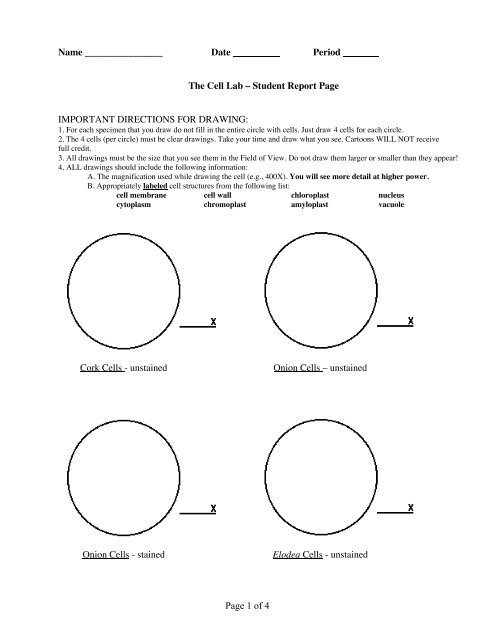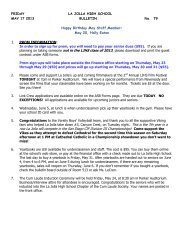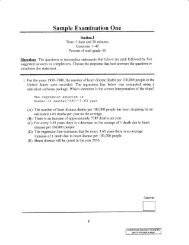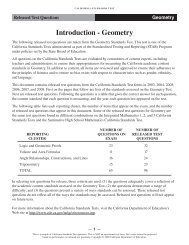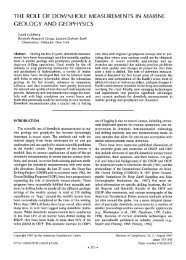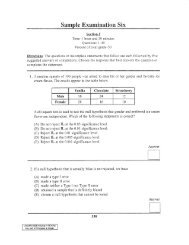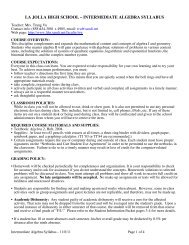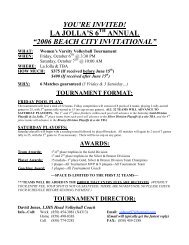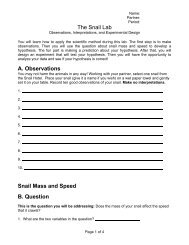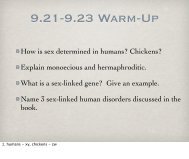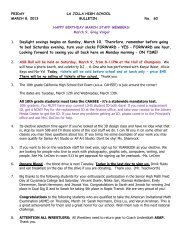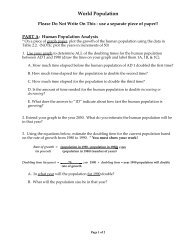Cell Lab Report
Cell Lab Report
Cell Lab Report
You also want an ePaper? Increase the reach of your titles
YUMPU automatically turns print PDFs into web optimized ePapers that Google loves.
Name ________________ Date Period<br />
The <strong>Cell</strong> <strong>Lab</strong> – Student <strong>Report</strong> Page<br />
IMPORTANT DIRECTIONS FOR DRAWING:<br />
1. For each specimen that you draw do not fill in the entire circle with cells. Just draw 4 cells for each circle.<br />
2. The 4 cells (per circle) must be clear drawings. Take your time and draw what you see. Cartoons WILL NOT receive<br />
full credit.<br />
3. All drawings must be the size that you see them in the Field of View. Do not draw them larger or smaller than they appear!<br />
4. ALL drawings should include the following information:<br />
A. The magnification used while drawing the cell (e.g., 400X). You will see more detail at higher power.<br />
B. Appropriately labeled cell structures from the following list:<br />
cell membrane cell wall chloroplast nucleus<br />
cytoplasm chromoplast amyloplast vacuole<br />
Cork <strong>Cell</strong>s - unstained Onion <strong>Cell</strong>s – unstained<br />
Onion <strong>Cell</strong>s - stained Elodea <strong>Cell</strong>s - unstained<br />
Page 1 of 4
Cheek <strong>Cell</strong>s - unstained Cheek <strong>Cell</strong>s - stained<br />
Potato <strong>Cell</strong>s - stained Bell Pepper <strong>Cell</strong>s – unstained<br />
Frog Blood <strong>Cell</strong>s – Bacteria <strong>Cell</strong>s -<br />
(prepared slides) (prepared slides – label the bacteria)<br />
Page 2 of 4
QUESTIONS: (Complete sentences for Full Credit!)<br />
A. Cork cells:<br />
1. What difference did you notice about the cells near the edge of your slice compared to the cells near<br />
the center of your slice? Explain!<br />
2. What cell structures do you see when looking at cork cells?<br />
3. Why do the cork cells appear to be empty?<br />
B. Onion cells:<br />
4. What microscopic evidence shows that the onion cell is a plant cell?<br />
5. What structures can be seen in an unstained onion cell.<br />
6. How do the stained onion cells appear differently than the unstained onion cells?<br />
7. Do the onion cells have chloroplasts? Why or why not?<br />
C. Elodea cells:<br />
8. How are Elodea cells the same and/or different than the onion cells?<br />
9. What are the functions of a cell wall?<br />
10. With regard to cytoplasmic streaming, what might be the function of this phenomenon?<br />
D. Cheek cells:<br />
11. How are cheek cells different from the plant cells you have studied?<br />
12. What is the purpose for staining cells?<br />
E. Potato cells:<br />
13. What structure can be seen with the aid of the iodine stain?<br />
14. Why are potatoes a good source of carbohydrates?<br />
F. Red Bell Pepper cells:<br />
15. What structure is visible in the bell pepper cell and not in any other cell in this investigation?<br />
Page 3 of 4
16. What is a similarity in the functions of the chloroplast and chromoplast?<br />
G. Frog Blood cells:<br />
17. What structures were present in the frog blood cells that were present in your cheek cells?<br />
H. Bacteria cells:<br />
18. Were any internal cell structures present? Why or why not?<br />
19. Compare the size and shape (appearance) of a bacterium cell to any one of the other cells observed.<br />
20. Are bacteria single cell or multicellular organisms? What evidence did you observe to support your<br />
answer? Hint: compare them to other organisms observed in this investigation!<br />
* Complete the following chart below based on “what you know” using “yes” or “no” and “E” or “P”<br />
Onion<br />
Cheek<br />
Elodea<br />
Cork<br />
Frog blood<br />
Bell pepper<br />
Potato<br />
Bacteria<br />
<strong>Cell</strong> wall <strong>Cell</strong> membrane<br />
Has Chloroplast, or Chromoplast,<br />
or Amyloplast<br />
(Please state which one if yes)<br />
Page 4 of 4<br />
Nucleus<br />
Eukaryotic<br />
or<br />
Prokaryotic


